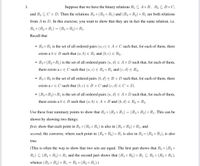
Advanced Engineering Mathematics
10th Edition
ISBN: 9780470458365
Author: Erwin Kreyszig
Publisher: Wiley, John & Sons, Incorporated
expand_more
expand_more
format_list_bulleted
Question
question is not difficul题,please give a full solution

Transcribed Image Text:1.
Suppose that we have the binary relations R1 C Ax B, R2 C B×C,
and R3 C C x D. Then the relations R3 o (R2 o R1) and (R3 o R2) o R1 are both relations
from A to D. In this exercise, you want to show that they are in fact the same relation, i.e.
R3 0 (R2 0 R1) = (R3 0 R2) o R1.
Recall that
• R2o Rị is the set of all ordered pairs (a, c) E A × C such that, for each of them, there
exists a b e B such that (a, b) E RỊ and (b, c) E R2,
R30 (R20 R1) is the set of all ordered pairs (a, d) E Ax D such that, for each of them,
there exists a c € C such that (a, c) E R2 o R1 and (c, d) E R3,
• R3 o R2 is the set of all ordered pairs (b, d) E B x D such that, for each of them, there
exists a c e C such that (b, c) E B × C and (c, d) E C × D,
• (R30 R2) o R1 is the set of all ordered pairs (a, d) E Ax D such that, for each of them,
there exists a b e B such that (a, b) E A × B and (b, d) e R2 × R3.
Use these four summary points to show that R3 o (R2 o R1) = (R3 o R2) o R1. This can be
shown by showing two things:
first, show that each point in R3 0 (R2 0 R1) is also in (R3 o R2) o R1, and
second, the converse, where each point in (R3 o R2) o R1 is also in R3 o (R2 o R1), is also
true.
(This is often the way to show that two sets are equal. The first part shows that R3 0 (R2 o
R1) C (R3 0 R2) ● R1 and the second part shows that (R3 o R2) o Rị C R3 0 (R2 o R1),
whence (R3 o R2) o R1 = R3 0 (R2 o R1).)
Expert Solution
This question has been solved!
Explore an expertly crafted, step-by-step solution for a thorough understanding of key concepts.
Step by stepSolved in 2 steps with 2 images

Knowledge Booster
Similar questions
arrow_back_ios
arrow_forward_ios
Recommended textbooks for you
 Advanced Engineering MathematicsAdvanced MathISBN:9780470458365Author:Erwin KreyszigPublisher:Wiley, John & Sons, Incorporated
Advanced Engineering MathematicsAdvanced MathISBN:9780470458365Author:Erwin KreyszigPublisher:Wiley, John & Sons, Incorporated Numerical Methods for EngineersAdvanced MathISBN:9780073397924Author:Steven C. Chapra Dr., Raymond P. CanalePublisher:McGraw-Hill Education
Numerical Methods for EngineersAdvanced MathISBN:9780073397924Author:Steven C. Chapra Dr., Raymond P. CanalePublisher:McGraw-Hill Education Introductory Mathematics for Engineering Applicat...Advanced MathISBN:9781118141809Author:Nathan KlingbeilPublisher:WILEY
Introductory Mathematics for Engineering Applicat...Advanced MathISBN:9781118141809Author:Nathan KlingbeilPublisher:WILEY Mathematics For Machine TechnologyAdvanced MathISBN:9781337798310Author:Peterson, John.Publisher:Cengage Learning,
Mathematics For Machine TechnologyAdvanced MathISBN:9781337798310Author:Peterson, John.Publisher:Cengage Learning,


Advanced Engineering Mathematics
Advanced Math
ISBN:9780470458365
Author:Erwin Kreyszig
Publisher:Wiley, John & Sons, Incorporated

Numerical Methods for Engineers
Advanced Math
ISBN:9780073397924
Author:Steven C. Chapra Dr., Raymond P. Canale
Publisher:McGraw-Hill Education

Introductory Mathematics for Engineering Applicat...
Advanced Math
ISBN:9781118141809
Author:Nathan Klingbeil
Publisher:WILEY

Mathematics For Machine Technology
Advanced Math
ISBN:9781337798310
Author:Peterson, John.
Publisher:Cengage Learning,

